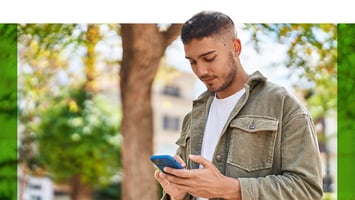Investing in a Short Message Service (SMS) marketing campaign is one of the best strategies to amp...
Email and SMS Marketing: A Guide to Integration
In the past, single-channel marketing strategies—such as advertising through print media or TV commercials alone—were the go-to for most businesses. Modern marketers, however, have a wide variety of mediums at their disposal to promote products and engage with customers. From social media to streaming platforms and search engines, there are countless advertising touchpoints available for optimization.
Two of the most salient are email and SMS marketing. Short Messaging Service (SMS) is the fastest way to reach potential customers, and email is one of the most widely utilized communication mediums on the planet.
Optimizing SMS and email marketing is essential for driving revenue for modern businesses. This article will lay out some practical guidelines and best practices for marrying the two into a masterful multi-channel marketing strategy.
The Power of Combining Email and SMS Marketing
There are nearly 4.5 billion registered email users worldwide. That’s over half the world’s population accessible from anywhere anytime. Likewise, email users are active and open to Business-to-Consumer (B2C) communications, as over three-quarters of marketers say they’ve seen increased email engagement over the last year.
Besides being universally used and accepted as a means of B2C communication, email is a highly effective marketing platform for a number of reasons:
- High character limits allow you to write longer messages and share more information with your base.
- You can easily attach links, pictures, videos, and other complex content to make emails more appealing to readers.
- They boast an impressive Return on Investment (ROI) of $36 for every dollar spent.
Email alone, however, isn’t enough to reach every potential customer and isn’t as reliable as SMS. A similar amount of people use SMS and email, but they’re much more likely to check a text than an email: while only about one-fifth of emails are ever opened, the rate for SMS is closer to 98%. Likewise, most people respond to text messages within 90 seconds—making it the fastest and easiest way to contact your clientele.
Thus, to reach the most consumers as quickly as possible, guarantee your messages are read, and still pack them with plenty of relevant information, use both SMS and email to market to potential customers.
Crafting Cohesive Email and SMS Campaigns
Crafting salient SMS and email campaigns that complement, rather than compete with each other is essential for marketing success. If you reach out to potential customers too often or use ineffective messaging, you’ll only annoy and deter them.
To make the most of your SMS and email marketing combo, pay close attention to the following:
1. Timing and Frequency
Message timing is a delicate balance. Send too often, and you risk overwhelming your audience or coming across as a spammer. Message too infrequently, however, and you may miss critical opportunities for customer engagement. Striking a perfect balance for message timing and frequency depends on the medium of communication:
- SMS – The United States Chamber of Commerce recommends two to six messages per month as the optimal amount to engage consumers without frustrating them. Likewise, the Telephone Consumer Protection Act (TCPA) dictates that businesses may not send promotional messages between 9 p.m. and 8 a.m. in the recipient's time zone—so stick to daytime messaging to avoid legal repercussions.
- Email – Promotional emails can be utilized much more frequently than SMS: most marketers send two to three per day, while just 12% send only one per week. Like SMS, daytime hours are best for sending emails as customers are more likely to check their inboxes than during the evening and early morning.
2. Content Balance
SMS messages are inherently short—with just 160 characters to work with, they’re best suited for snappy snippets of information. However, SMS isn’t the only kind of mobile messaging you can use to reach out to your base.
Multimedia Messaging Service (MMS) allows you to enhance your texts with photos, videos, and other eye-catching assets. MMS messages can elicit up to three times the engagement of standard SMS messages—so make sure to incorporate high-quality pictures of your products and services into your upcoming text blasts.
When it comes to email content, keep these essential tips in mind to craft more effective messages:
- Segmented emails receive much more engagement than unsegmented ones, so be sure to divide your audience and tailor messages to match their sensibilities.
- Like SMS and MMS, emails with photos and videos perform significantly better than plain text alone.
- Personalized messages containing captivating subject lines and special offers receive the most engagement of promotional emails.
3. Cross-Promotion Techniques
SMS and email are dynamic duos that can be used in tandem to boost customer interest in your business and your bottom line. To optimize both for promotional purposes, start by securing the easiest of the two from your clientele: email.
90% of consumers are willing to share their email addresses for small incentives, such as discounts, while only about 6% would do the same with their phone numbers. However, after you have their email, you can convince them to part ways with their number with further incentives or when they purchase.
Once you have both pieces of essential contact information, you can use them to effectively cross-promote your business. Send similar messages across both mediums for sales, offers, and other events to drum up the most possible interest. You can even use complex messaging tactics—such as emailing codes your audience can text you to receive a discount (or vice-versa)—to increase engagement on both platforms and reward your most loyal customers.
Integration Examples
There’s no telling how or where a consumer will encounter your brand or products next. That’s why it’s critical to integrate both SMS and email into a cohesive marketing strategy that maintains a consistent tone and approach across all your channels.
Consider, for instance, if you want to throw a flash sale and have as many people as possible participate. By promoting it via SMS and email, you’ll be able to reach customers while they’re on the road, at work, relaxing at home, or anywhere else—meaning maximum reach and conversions.
You can also utilize information from both mediums to inform your brand’s personalization efforts. Collate key customer details you learn from either platform—such as name, location, and gender—and use them to craft more salient messages on both. More than two-thirds of consumers expect customized B2C interactions—so collect and organize customer data as effectively as possible to build better, more personalized communication across your platforms.
Best Practices for Integrated Marketing Campaigns
SMS and email are the two best platforms for getting in touch with your audience and promoting your products—but only if you use them effectively. To leverage both email and SMS for maximum engagement and ROI, utilize:
1. Consistent Branding and Voice
No matter how many channels you utilize, 90% of consumers expect their experience of your brand to be consistent across all of them. When it comes to two similar mediums—such as email and texting—consistency becomes even more important.
To provide your audience with similar interactions across both SMS and email, make sure to:
- Utilize a consistent tone—whether it’s serious, whimsical, or informative—across both.
- Promote the same deals, sales, and offers.
- Employ personalization efforts—such as calling customers by their names and suggesting the products they may like—on both mediums.
2. Legal and Ethical Considerations
Besides the TCPA, other stringent guidelines dictate how you can and can’t email and text potential customers. The other two major regulations you’ll need to comply with are:
- The General Data Protection Regulation (GDPR) – The GDPR governs how companies can email consumers within the European Union (EU). Even if your business isn’t registered in Europe, breaking its rules can still lead to fines and punishment. The highlights include getting consent before sending messages, avoiding spam, and taking secure measures to safeguard users’ emails and other sensitive information.
- CTIA standards – The CTIA is an industry lobbying group that advises the government on wireless communication standards. They routinely create lists of best practices businesses should follow for all SMS communications. Most recently, they’ve featured guidelines such as obtaining consent, identifying promotional messages as such, and giving users the option to opt out with every text.
Leverage Mozeo to Make the Most of Your SMS and Email Campaigns
Combining email and SMS marketing is essential to success for modern businesses. Using both mediums maximizes your reach and encourages more engagement from your audience. Multichannel campaigns—such as those that leverage SMS and email—benefit from nearly four times as much user engagement as marketing efforts that use only one platform.
To simplify SMS management for your business, trust the tool that thousands rely on for their messaging needs: Mozeo. Mozeo helps you segment your audience and craft captivating SMS messages that encourage engagement and interest in your brand.
Learn more about Mozeo and sign up today to start your free trial.




